
Brooklyn Creek Watershed Society President Robert Deane at the mouth of the stream Photo by George Le Masurier
Brooklyn Creek: it’s surviving, but faces old and new threats from upstream development
This is the third in a series of articles
The Comox Valley is fortunate to have several waterways in its urban environment that support salmon and other fish. But it also has many that are either dead or an aquatic life support.
Brooklyn Creek in Comox had an usually big run of salmon two years ago, but it normally can only manage to sustain a smattering of fish. But it does still have fish, primarily thanks to an active group of stream keeper volunteers, who have grand plans to revitalize the creek with a pathway from Comox Bay to Courtenay.
They face difficult challenges from multiple jurisdictional governance, an uncertain future of the creeks’ great asset and a powerful developer operating in its headwaters.
The problems for Brooklyn Creek begin at its headwaters
Until about 30 years ago, most of the rainwater that fell in the natural forest at the top of Ryan Road Hill was soaked into the ground, about 50 percent. Some evaporated back into the atmosphere, about 40 percent.
And about 10 percent trickled down the surface of the southeast slope toward Comox Harbour, forming many tiny tributaries that eventually came together as Brooklyn Creek.
It would have taken days, perhaps weeks, for a drop of surface water in the creek to travel from the top of the hill to Comox Harbour. The water that had soaked into the ground wouldn’t have reached the harbour for years.
But then the Crown Isle golf course and residential community was built by the Silverado Corporation, followed by the Cascadia Mall and other commercial development further up the slope. With the trees and natural vegetation replaced by impervious surfaces, the hydrology changed.
 Now, only about 30 percent of the rain evaporates, and only 15 percent or less soaks into the ground. That leaves more than 55 percent of the rainfall to runoff from streets and roofs and cause flooding, if it isn’t somehow managed.
Now, only about 30 percent of the rain evaporates, and only 15 percent or less soaks into the ground. That leaves more than 55 percent of the rainfall to runoff from streets and roofs and cause flooding, if it isn’t somehow managed.
So Crown Isle captures this excess rainfall through storm drains opening into large underground pipes, and dumps it all into Brooklyn Creek. Lower down the slope to Comox Harbour, the Town of Comox does the same thing.
There are, in fact, 24 stormwater pipes emptying into Brooklyn Creek today, carrying water contaminated with oil and heavy metals left by automobiles, pesticides, herbicides and animal feces.
And the pipes gush toxic water at such a high volume and fast rate after rainfalls that, without the efforts of the Brooklyn Creek Watershed Society, the stream today would be dead.
That it can still sustain a small spawn of fish today is a miracle.
Brooklyn Creek Watershed Society
“That the stream can sometimes support salmon and trout in an urban environment is just magic,” Robert Deane, president of the Brooklyn Creek Watershed Society, told Decafnation. The group was formerly known as the Brooklyn Creek Stream Keepers.
But it’s more than magic, it’s long hours of hard work by a dedicated group of volunteers. For the last 12 years, society volunteers have done in-stream work on the lower creek section within the Town of Comox to create new fish habitat.
The volunteers have replaced what was destroyed by erosion from raging flows after rainfalls or by unwitting property owners along the creek who engaged in “stream cleaning.” They hauled in logs every year to create fish passages, rock dams, pools and riffles to mimic naturally occurring spawning grounds.
They have slowly rerouted the walking paths that follow the creek from its mouth up to Noel Avenue, near the private elementary school, to move them away from the creek and allow more natural vegetation to cover its banks. Fish need shade and cool water temperatures.
They do an annual smolt count to monitor the health of the creek for wildlife.
And they launched a new program this year on Earth Day to tackle the invasive species, such as English Ivy, that are crowding out natural vegetation. The stream keepers spent two days hacking away invasive growth and only cleared 50 metres of the stream. But their work filled a two-ton truck, donated by the Town of Comox to haul away the debris.
“The town has been a good partner,” Deane said. “Our aims and the town’s aims are aligned.”
To curtail flooding and downstream erosion of creekside properties, the town spent nearly $2 million in the early 2000s to install a flow diverter near Pritchard Road with a threshold gate. After heavy rainfalls, as much as 70 percent of the stormwater gets diverted into a pipe that discharges directly into Comox Harbor near Filberg Park.
But both Deane and another stream keeper, Larry Jefferson, suspect it’s not working as well as it used to, taking flow out of the creek that it needs in the drier summer months to sustain life.
“The diverter requires maintenance, and it soon will have to be rehabilitated,” Jefferson said.
The stream keepers apply for grants every year to support their projects and the town usually matches them. Combined, they have spent over $100,000 in the last 10 years, he said.
All of this work on the bottom end has made the creek more resilient to the upstream issues in Courtenay and Area B.
A multi-jurisdictional dilemma
Most people think of Brooklyn Creek as a stream that flows through Comox. That’s probably because the Comox section is mostly visible and offers a creekside pathway down through Mack Laing Park to its mouth into the harbour.
But Brooklyn Creek actually starts in Courtenay at Crown Isle and then travels through Area B on the northwest side of Anderton Road and across Birkdale Farm, before crossing Guthrie Road into Comox.
 All three local governments don’t necessarily have the same attitude toward the creek, or urban creeks in general. And that makes it hard to create a common 100-year plan for the entire watershed.
All three local governments don’t necessarily have the same attitude toward the creek, or urban creeks in general. And that makes it hard to create a common 100-year plan for the entire watershed.
In August, the Partnership for Water Sustainability in B.C. (PWSBC), released a Ecological Accounting Process (EAP) report that showed the monetary value of Brooklyn Creek to the Town of Comox in terms of its stormwater conveyance system — to oversimplify, what the town would have to spend if the creek didn’t exist.
Tim Pringle, chair of the EAP initiative for PWSBC, says application of the EAP provides local governments with a way to select solutions for drainage infrastructure that draw from both nature’s assets and engineered works.
“This would accomplish two desired outcomes: protect watershed health (hydrological functions); and achieve a balanced approach to funding life-cycle costs,” he said.
The Brooklyn Creek EAP report praises the cooperation between the town and the watershed society, and notes that Courtenay and the CVRD do not have Brooklyn Creek management plans.
“It’s the first EAP in B.C. for a natural asset that resides in multiple jurisdictions,” Vanessa Scott, a member of the watershed society, told Decafnation. “It was a pilot project showing the way forward for municipalities to adapt to climate change.”
The EAP report measures the creek’s value in terms of property values, green space, stormwater conveyance, volunteers hours and grant funding. It was presented to Comox Council in August.
But when the council was asked at the end of the presentation to create a Brooklyn Creekshed plan, no council member would make the motion, Scott said. The council instead asked staff to make a recommendation sometime this fall.
The main problem, as Deane sees it, is that the problems created for the creek by Crown Isle and other headwaters developments don’t impact anyone in Courtenay. All the impacts are felt by downstream property owners in Area B and Comox.
“I would like to have some Crown Isle residents, or just Courtenay residents, join our group,” Deane said.
Scott says people should not assume their local governments are looking after their streams.
“The lack of a management plan for upper and middle Brooklyn Creek threatens all the work done in Comox,” she said. “Comox is a stakeholder in Courtenay development, but there’s no multi-party management plan.”
Birkdale Farm
 Guy Sim runs a dairy farm on about 190 acres, most of it bordered by Guthrie, Knight and Anderton roads. It’s a family farm started by his grandparents, George and Mabel Laban, in 1920. His father, Alex Sim, took it over in 1950 and passed it on to Guy in 1970.
Guy Sim runs a dairy farm on about 190 acres, most of it bordered by Guthrie, Knight and Anderton roads. It’s a family farm started by his grandparents, George and Mabel Laban, in 1920. His father, Alex Sim, took it over in 1950 and passed it on to Guy in 1970.
The farm acts as a giant sponge that soaks up some of the creek’s water into the ground, and provides the riparian vegetation around the creek that fish need.
Brooklyn Creek cuts a Z-shaped swath across the main farmland, flooding portions of his field many times every year. It didn’t used to flood so often.
The creek used to only flood after an rare heavy rain. Now — after the development of Crown Isle — it takes much less rain to cause flooding. Sim said even a half-inch of rain causes flows in the creek to breach its banks.
In one spot where a farm road for moving equipment crosses the creek, there used to be two 36-inch culverts that handled peak flows. Sims added a third 36-inch culvert to handle the increase in creek volume coming from the deforestation of Crown Isle and Lannan Forest, and they still overflow.
The flooding kills his grass if the water lingers more than a day or two, and after a flood swans and ducks fly in to eat the submerged grass when it’s easy to pull up.
He needs the grass to feed herd of about 230 Ayrshire cows. He has to purchase additional feed to get through the winter.
And when it floods, Sim can’t let his cow graze in those areas because their hooves would tear up the soggy ground. Nor can he move his equipment in such soft ground.
And it’s not just flooding that causes Sim hardships. Garbage like plastics and other debris get into the creek and spill out onto his grazing land.
Sim has fought with local governments for years, He’s asked for a pond where the creek enters at the northwestern portion of this property, something a consultant report recommended many years ago. But it was never done.
Facing new threats
Despite the Crown Isle development and the loss in 2008 of the Lannan Forest, a 40-acre parcel of second-growth trees adjacent to Longland’s Golf Course, which is a secondary headwaters of Brooklyn Creek, the stream is surviving, if barely.
But there are new threats on the horizon.
Silverado has purchased Longlands property. The Crown Isle developer says they have no plans to redevelop the par-three golf course, but a future development there would pile additional pressure on the creek.
And Guy Sim is nearing retirement age, but he has no family to take over the farm. The Brooklyn Creek Watershed Society worries about what might happen to this prime land in the Agricultural Land Reserve if Sim decides to sell.
Sim himself doesn’t know what he will do when that time comes.
“I’m working on a plan,” he told Decafnation.
Chris Hilliar, a former Comox officer with the Department of Fisheries and Oceans, said Sim’s farm is “the best thing Brooklyn Creeks has going for it.”
“It would be a travesty if that place is ever developed,” he said.
Looking ahead
Robert Deane, president of the Brooklyn Watershed Society, says there is a vision that could save Brooklyn Creek from dying the “death by a thousand cuts” that has killed other urban streams, like Golf Creek.
Deane and others envision extending the walking trail along the creek all the way through Sim’s farm, along the right of way next to Idien’s Way and into Crown Isle.
When the Comox Valley Regional District installed the new Hudson trunk sewer line, from Crown Isle along Parry Place and Idien’s Way, the steam keepers convinced them to set it off to the side of the road and create a right of way for an eventual trail. The creek follows the same route.
“That may seem contrary to the objective of keeping the creek natural,” Deane said. “But if people use the pathway and see the creek, then they will own it and be supportive.”
“The Tsolum River was brought back life,” Deane said. “All we have to do is give them good, clean water, and the fish will do the rest.”
“Brooklyn Creek is a small creekshed whose hydrology and ecological services have been altered and degraded by decades of land use impacts,” — Tim Pringle in the preface to Assessing the Worth of Ecological Services Using the Ecological Accounting Process for Watershed Assessment: Brooklyn Creek Demonstration Application in the Comox Valley.
WHAT IS THE ECOLOGICAL ACCOUNTING PROCESS (EAP)?
Ecological Accounting Process — “The EAP approach begins by first recognizing the importance of a stream in a natural state and then asking: how can we maintain those ecological values while allowing the stream to be used for drainage,” says Jim Dumont, Engineering Applications Authority with the Partnership for Water Sustainability in BC.
“If communities are to truly benefit from use of nature’s assets to provide vital community infrastructure services, then two issues must first be recognized as being impediments to changes in practice.”
“The first issue is the widespread lack of understanding of the relationship between flow-duration and stream (watershed) health.”
“The second issue is the widespread application of a standard of practice that has led to the current situation of degraded streams, and that has little connection to real-world hydrology.”
HOW YOU CAN CONTRIBUTE
JOIN — You can join the Brooklyn Creek Watershed Society or donate to them.
DONATE — The Comox Valley Conservation Partnership accepts members and donations. The CVCP was formed in 2008, after concern was raised that there was no regional plan in the Comox Valley to prioritize and protect sensitive ecosystems on private land. The CVCP brings together local community-based groups and other stakeholders to support their projects and provide a voice for the value of conservation in our natural areas. The CVCP is administered by a program coordinator under the direction of the Comox Valley Lands Trust
STORMWATER GLOSSARY
HYDROLOGIC CYCLE — The endless circulation of water. From the beginning of time when water first appeared, it has been constant in quantity and continuously in motions. The same water molecules have been transferred time and time again from the oceans and the land into the atmosphere by evaporation, dropped on the land as precipitation and transferred back to the sea by rivers and ground water.
LOW-IMPACT DEVELOPMENT(LID) — The systems and practices that use or mimic natural processes that result in the infiltration, evapotranspiration or use of stormwater in order to protect water quality and associated aquatic habitat.
RAIN GARDEN — A miniature wetland in a residential setting, lower than the adjacent grade to collect rainwater from roofs, driveways or streets, thus allowing infiltration into the ground.
RIPARIAN AREAS REGULATION — Riparian areas link water to land. They border streams, lakes, and wetlands. The blend of streambed, water, trees, shrubs and grasses in a riparian area provides fish habitat, and directly influences it. Read more here
STREAMSIDE PROTECTION REGULATION — A fish protection act preceding the Riparian Areas Regulation. Read more here
RUNOFF — Excessive rain or snowmelt that produces overland flow to creeks and ditches. Runoff is visible flow of water in rivers, creeks and lakes as the water stored in the basin drains out.
TRANSPIRATION — Water vapour emitted from a plant. Every day an actively growing plant transpires five to 10 times as much water as it can hold at once.

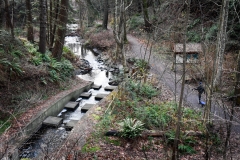
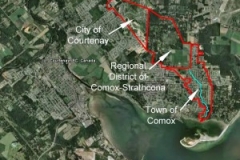
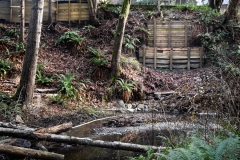


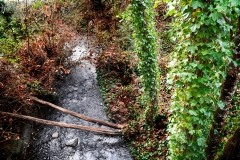
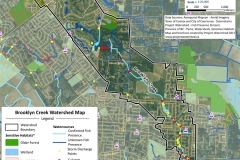
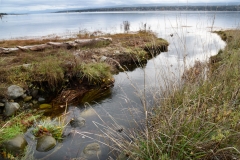
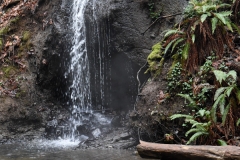
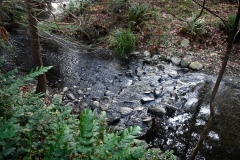
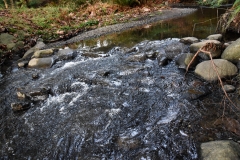
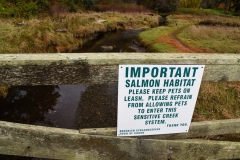
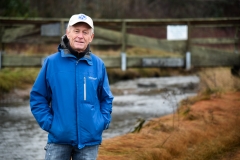
Written in memory of Lannon Forest on behalf of (inspired by) the Silverado robber barons.
With sincere apologies to Joyce Kilmer who appropriately enough has a park bearing his name in New York city.
Eulogy and Legacy
I think that i shall never see
A tree as lovely as money
the trees i surely must confess
were made for me and not the rest
a tree may look at god all day
while in its branches children play
i care not that it does share
the stuff of life, fresh clean air
and holds for us with equal gain
life sustaining sweet water rain
and when some day i am wrapped in oak
these words about me will be spoke
‘a petty man with no true vision
whose love of money was his prison’